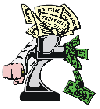INFORMATION ARTICLE

 |
Three Steps To
Wealth |
[The following article is an excerpt from John Behle's book Mortgage Magic, which is part of The Paper Game Trilogy.] One of the tried and proven techniques of profiting through real estate investment is a well known three-step process. The steps to this simple process are: STEP 1 - Buy a piece of real estate under the most favorable terms and conditions possible with as much leverage (OPM--other people's money) as you can. STEP 2 - Fix it up or improve it in some way. This step could involve anything from paint and elbow grease to converting an apartment complex to condominiums or timeshares. STEP 3 - Sell or finance the real estate in some way to be able to compound profits and find more real estate to follow the same three-step process. This three-step process can be applied to other forms of real estate investment as well. One of the most profitable of these is in the field of "real estate paper," which includes: contracts, trust deed notes and mortgage notes. What a person buys when they buy real estate "paper" is the right to receive a future income in the form of a series of payments and/or a lump sum payment. Buying paper involves buying the note on a property and having the property as security for the payment of the note. Paper has long been known to be one of the safest, most secure investments available. Now it is taking a whole new change of direction and is becoming one of the most creative and profitable forms of investment. Paper Can Be Leveraged A similar three-step process is being used very successfully in the field of real estate paper. Investors have invested in paper for years and years, but seldom have used the principle of leverage. Paper can be financed just as real estate can be financed. There are many institutional and private sources of financing available for real estate paper which can make it as easy to finance as real estate. Paper can be financed 100 percent and at a lower rate of interest than it is bringing in. For example, you might buy a $10,000 note at a discount of 40 percent for $6,000. Your yield or rate of return might be 24 percent, but you might borrow the entire $6,000 at 17 percent--which would give you a 7 percent return on borrowed money. In the case of this note, that would mean an immediate cash flow of over $30 per month. Since it was borrowed money, this monthly cash flow would be free to you. Also, you would show an immediate increase in your net worth of $4,000 (the amount of the discount) because you have a loan of $6,000 which purchased an asset of $10,000 (the face value of the note). Wouldn't it be fun if you just did this first step 10 or 20 times? Paper Can Be Improved How in the world can you fix up paper? You can't paint it and re-carpet it, but you definitely can improve it. You can't raise rents, but you can raise the payments. You can't do a condo conversion on it, but you can restructure it. There are over 117 different ways to improve real estate paper. I will discuss one way of improving real estate paper that is so simple, you will have wished you knew about it several years ago. Sell Paper At A Profit Once the paper has been improved or "fixed up" in some way it can then be resold at a profit or refinanced to be able to keep the profits compounding at an astronomical rate. Let's look at the three steps: STEP 1 - Buy or control paper through one of 11 different sources and finance paper through one of 12 different sources. STEP 2 - Improve paper through one of over 30 different ways all of which are very advantageous to all parties involved in the transaction. STEP 3 - Sell for a profit or refinance. Sell It To The Payor One of the quickest and easiest ways to make profits in real estate paper is to sell it back to the payor. You might buy a note at a 40 percent discount and sell it to the payor at a discount of 25 percent. You would think that the first person that the seller of a note would contact when he wants to sell his note would be the one paying on it, but most of the time they don't. They assume that if they could pay off the note that they would have already done so or that if they had any interest they would have already contacted them. This means that we can make a profit by just asking the person the simple question of whether they would like to pay off their note at a discount. An example might be where you purchase a $10,000 note at a discount of 40% or a price of $6,000. We could then contact the person paying on the note and offer them the opportunity to pay off the note for $7,500. This would mean a profit to you of $1500 on an investment of $6,000 and could happen in as little as 30 days. This would be a 25% profit on your investment, which doesn't sound too exciting until you consider that you did it in only one month. If you financed the note, then you would have made that $1500 without even needing to invest anything but your time. What if you had purchased a $100,000 note? Would $15,000 profit in 30 days interest you? As soon as a person gets over the shock of this simple way to make a big profit, they usually ask this question, "What if the people don't have the money to pay off their note at a discount?" Some people will have the ability to pay off the note, but most will not happen to have $6,000 stuffed in their mattress. An Offer They Won't Refuse What if you could approach a person paying you on a note and show them a way to: * LOWER THEIR MONTHLY PAYMENT * LOWER THEIR LOAN AMOUNT BY $2,000 * PAY OFF THEIR LOAN IN THE SAME AMOUNT OF TIME * PUT $500 CASH IN THEIR POCKET * AND YOU'LL MAKE $1500 IN THE PROCESS Do you think you might be able to get their attention if you could make them an offer like that? If they don't get excited, then you better check for a pulse and call for the paramedics. They might also get a skeptical look on their face and start looking for the "Candid Camera." Here's how to do it: If the person paying you on the note were to go to the bank and put on a new loan for $8,000, they would have $500 cash left over after paying you the $7500 that you said you would take for their $10,000 note that they owe to you. The terms on the original note were as follows: The terms on the new note are: As you can see, the amount of the new loan is $2,000 less and the interest rate is higher. The term of the loan is the same, but the payment is actually lower. Summary Of The Three Steps Here's a summary of the three-step process and how it would apply to this particular situation. STEP 1 - Sam calls you on your newspaper ad about buying notes. You purchase his $10,000 note at a 40% discount for $6,000. Your bank or an investor loans you the $6,000 at 17% and you buy the note at a 24% yield or rate of return. STEP 2 - You meet with Paul that pays on the note and offer him a discount. Paul agrees to pay off the note at a 25% discount for $7500. He doesn't have the cash, so Paul gets a loan from the bank for $8,000 and puts $500.00 in his pocket. Paul has lowered his monthly payment and made a profit at the same time. STEP 3 - In this case, there would be no need to further finance or sell this note, because in step 2 you sold it to the most logical person - the buyer. Profits For You This is another example of a very profitable form of investment that will become increasingly more popular in the coming years. Paper has many uses and profits can be made in many different ways. Shouldn't you be making these profits too? About the Author . . . John D. Behle is one of the foremost educators and practitioners in the field of discounted paper investment. His innovative strategies and techniques have shaped the industry. With over two decades in the industry and an extensive background in real estate and finance, John Behle adds a wealth of knowledge and experience to his creative money-making techniques. John holds an National Council of Exchangors "Gold Card" and an EMS designation. He is also listed in Who's Who In Creative Real Estate. John Behle is the author of several hundred articles published in national magazines and newsletters and of several ground-breaking real estate paper books, including: * The
Paper Game Trilogy [Return to Menu] |
|
![]() To
Fax this article to someone else for free click on the
box.
To
Fax this article to someone else for free click on the
box.
Home
Free Articles